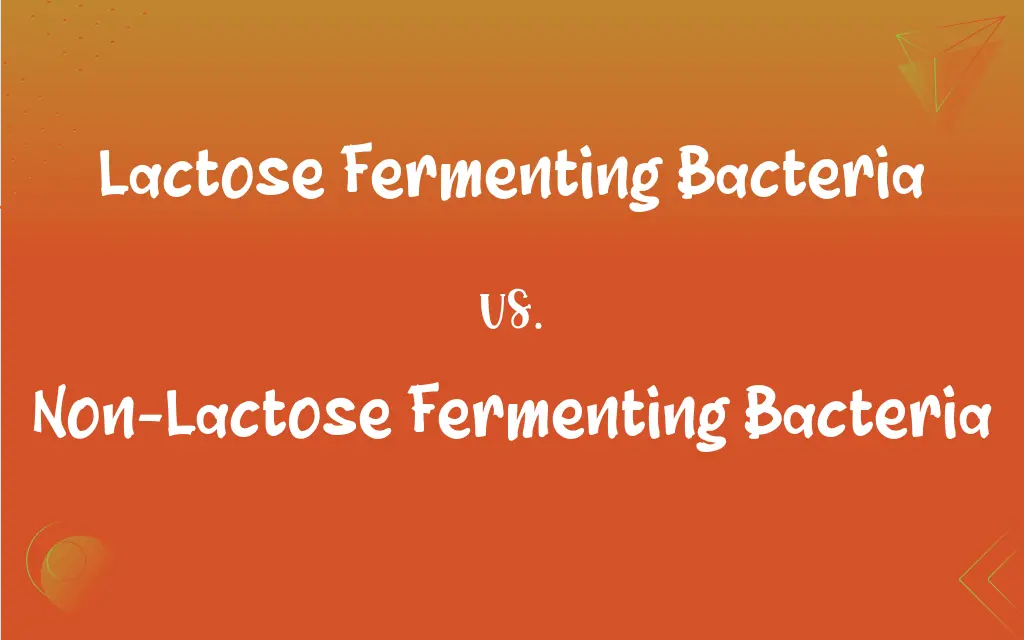Lactose Fermenting Bacteria vs. Non-Lactose Fermenting Bacteria: What's the Difference?
By Aimie Carlson & Harlon Moss || Published on March 3, 2024
Lactose fermenting bacteria metabolize lactose to produce gas and acid, while non-lactose fermenting bacteria cannot, often leading to colorless colonies on differential media.

Key Differences
Lactose fermenting bacteria have the ability to metabolize lactose, utilizing it as a source of energy and producing lactic acid, gas, or both as byproducts. This process is a significant trait used in microbiology to differentiate bacterial species, particularly in the gastrointestinal tract where lactose availability is common. In contrast, non-lactose fermenting bacteria lack the enzymes necessary to break down lactose. Their inability to ferment lactose differentiates them in diagnostic mediums, as they do not produce the acid or gas that lactose fermenters do, often resulting in colorless or differently colored colonies on selective media like MacConkey agar.
Lactose fermenting bacteria, such as Escherichia coli, are indicative of the coliform group, which includes bacteria that are potentially pathogenic and commonly found in the intestinal tract of humans and animals. These bacteria are important indicators of fecal contamination in water and food. Non-lactose fermenting bacteria, such as Salmonella and Shigella, do not metabolize lactose and are also significant pathogens, but their identification requires differentiating them from lactose fermenters through specific biochemical tests.
In laboratory settings, the ability or inability to ferment lactose is exploited using differential media, which contain lactose and pH indicators to visually distinguish between lactose fermenting and non-lactose fermenting bacteria based on colony color and surrounding media changes. Lactose fermenting bacteria typically produce pink or red colonies due to acid production, whereas non-lactose fermenting bacteria produce pale or colorless colonies as they do not alter the pH in the same manner.
Detection of lactose fermenting bacteria is crucial in clinical diagnostics, food safety, and public health to identify and control the spread of gastrointestinal infections. Non-lactose fermenting bacteria, although not utilizing lactose, play a critical role in identifying and managing infections caused by organisms that require different nutritional requirements to grow, showcasing the diversity in bacterial metabolic capabilities.
Comparison Chart
Metabolic Capability
Can ferment lactose
Cannot ferment lactose
ADVERTISEMENT
Byproducts
Produce acid and possibly gas
Do not produce acid from lactose
Colony Color on MacConkey Agar
Pink or red colonies
Colorless or pale colonies
Indicator of
Fecal contamination
Pathogens with different metabolism
Typical Examples
Escherichia coli, Enterobacter
Salmonella, Shigella
Lactose Fermenting Bacteria and Non-Lactose Fermenting Bacteria Definitions
Lactose Fermenting Bacteria
Organisms that metabolize lactose to acid and gas.
E. coli, a lactose fermenting bacterium, turned the MacConkey agar pink.
ADVERTISEMENT
Non-Lactose Fermenting Bacteria
Non-lactose fermenting bacteria do not metabolize lactose.
Salmonella does not ferment lactose, aiding in its identification in the lab.
Lactose Fermenting Bacteria
Microbes that can utilize lactose as an energy source.
The lactose fermenting bacteria in the sample indicated possible fecal contamination.
Non-Lactose Fermenting Bacteria
Often associated with specific gastrointestinal diseases.
Shigella spp., a non-lactose fermenter, causes dysentery.
Lactose Fermenting Bacteria
Bacteria producing lactic acid from lactose.
Lactose fermenting bacteria are used in dairy fermentation processes.
Non-Lactose Fermenting Bacteria
Critical in differentiating pathogenic bacteria in diagnostics.
The inability to ferment lactose helps distinguish Salmonella from E. coli in contaminated food samples.
Lactose Fermenting Bacteria
Coliform bacteria that ferment lactose with acid production.
Water testing revealed lactose fermenting bacteria, signaling contamination.
Non-Lactose Fermenting Bacteria
Require alternative metabolic pathways for energy.
Non-lactose fermenters like Pseudomonas aeruginosa utilize proteins and fats.
Lactose Fermenting Bacteria
Pathogens that break down lactose, indicating potential health risks.
The presence of lactose fermenting bacteria in food can signify spoilage.
Non-Lactose Fermenting Bacteria
Identified by colorless or clear colonies on specific media.
Salmonella spp. produce colorless colonies on MacConkey agar.
FAQs
Are there any exceptions to bacteria that do not ferment lactose but are still beneficial?
Yes, some beneficial bacteria may not ferment lactose but contribute to gut health through other metabolic activities, such as Bifidobacteria.
Why is lactose fermentation important in microbiology?
Lactose fermentation is a key metabolic characteristic used to differentiate and identify bacteria, especially in clinical diagnostics.
What media is used to identify lactose fermenting bacteria?
MacConkey agar is commonly used, where lactose fermenters produce pink colonies, while non-fermenters remain colorless or clear.
Can non-lactose fermenting bacteria be harmful?
Yes, many non-lactose fermenting bacteria, such as Salmonella and Shigella, are pathogenic and can cause serious gastrointestinal diseases.
How do lactose fermenting bacteria affect the human gut?
They are part of the normal gut flora and play a role in digestion; however, overgrowth can lead to infections and digestive issues.
What role do non-lactose fermenting bacteria play in food safety?
Identifying non-lactose fermenters like Salmonella is crucial in food safety protocols to prevent foodborne illnesses.
Can lactose intolerance be affected by lactose fermenting bacteria?
Lactose fermenting bacteria can sometimes aid in lactose digestion, potentially alleviating symptoms for some people with lactose intolerance.
How is lactose fermentation tested in the laboratory?
Through culture on selective media like MacConkey agar and observing for acid production, indicated by a color change.
Are there environmental factors that influence lactose fermentation in bacteria?
Yes, factors like temperature, pH, and oxygen availability can affect the efficiency of lactose fermentation in bacteria.
Can antibiotics differentiate between lactose and non-lactose fermenting bacteria?
Antibiotics target specific bacterial mechanisms and are not selected based on lactose fermentation but may be chosen based on the bacterial species identified.
How do antibiotics affect lactose fermenting bacteria in the gut?
Antibiotics can disrupt the balance of gut flora, reducing lactose fermenting bacteria and potentially affecting lactose digestion.
Is it possible for a bacterium to switch between lactose fermenting and non-fermenting states?
Generally, bacteria are genetically programmed for their metabolic pathways, including lactose fermentation. Mutations or gene acquisition can alter these capabilities, but it's not common for bacteria to switch states actively.
How does lactose fermentation affect the pH of the medium?
Lactose fermentation produces acid, lowering the pH of the medium, which is often visualized by a color change in pH-sensitive media.
How do lactose fermenting bacteria contribute to food production?
They are used in the dairy industry to ferment lactose in milk, producing yogurt, cheese, and other fermented dairy products.
Can lactose fermenting bacteria be used in probiotics?
Yes, some lactose fermenting bacteria are used in probiotic supplements to support gut health and aid in lactose digestion.
What are the implications of lactose fermentation in wastewater treatment?
Lactose fermenting bacteria can be employed in the biological treatment of dairy wastewater to reduce lactose content before discharge.
How do non-lactose fermenting bacteria survive in environments rich in lactose?
They utilize other carbon sources for energy or possess alternative metabolic pathways to metabolize non-lactose sugars.
What genetic mechanisms enable bacteria to ferment lactose?
The presence of the lac operon, a gene cluster that codes for proteins involved in lactose metabolism, enables bacteria to ferment lactose.
Is there a role for lactose fermenting bacteria in biotechnology beyond food production?
Yes, lactose fermenting bacteria are used in biotechnology for the production of bioethanol, biopolymers, and pharmaceuticals, leveraging their metabolic pathways for biosynthesis.
Can lactose fermenting bacteria cause food spoilage?
Yes, lactose fermenting bacteria can spoil lactose-rich foods by producing off-flavors and gas, leading to spoilage.
About Author
Written by
Aimie CarlsonAimie Carlson, holding a master's degree in English literature, is a fervent English language enthusiast. She lends her writing talents to Difference Wiki, a prominent website that specializes in comparisons, offering readers insightful analyses that both captivate and inform.
Co-written by
Harlon MossHarlon is a seasoned quality moderator and accomplished content writer for Difference Wiki. An alumnus of the prestigious University of California, he earned his degree in Computer Science. Leveraging his academic background, Harlon brings a meticulous and informed perspective to his work, ensuring content accuracy and excellence.































































